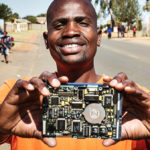 This post was written by guest blogger Alexa Schmidt, Senior Technology for Impact Program Manager, Mercy Corps.
This post was written by guest blogger Alexa Schmidt, Senior Technology for Impact Program Manager, Mercy Corps.
The organization I work for—Mercy Corps—strives to alleviate suffering, poverty, and oppression through economic development and emergency relief programs around the world. This work has always been challenging.
We’ve seen firsthand the fragmentation of armed actors in the Syrian War or increasing climate variability in the Horn of Africa, a region already made vulnerable by poverty and violent extremism. Add to this complexity, an emerging digital space where media platforms are used to recruit terrorists, manipulate voters, or incite violence against minorities.
In this environment, Mercy Corps’ Technology for Development team imagines a world where humanitarian actors use digital tools to improve people’s safety and livelihoods. Instead of being used to divide, digital platforms could be used instead to help communities cope and adapt, anticipate and prevent, and where possible, transform underlying drivers of violence.
In our partnership with Cisco, we have begun to pilot tech-based interventions like using sentiment analysis to monitor hate speech. While organizations like Mercy Corps have long recognized the potential for data science to improve our work, we’ve had less time to test different use cases and refine our approach.
In early May, I had the opportunity to join representatives from Bayer, 3M, and the Food and Drug Administration at the U.S. Chamber of Commerce Foundation’s Digital Empowers Summit. The other panelists and I gathered to discuss improvements to people’s lives and the planet through data science.

Everyone on the panel alongside me spoke confidently about the ways that data science had improved private or governmental capacities, and in doing so, had extended those benefits to consumers, whether through agricultural traceability, detecting counterfeit products, or by improving seed productivity.
Unlike my co-panelist from Bayer, who spoke about a sophisticated data science team of 500 people, Mercy Corps has a small team of over half a dozen analysts who draw from qualitative and quantitative data to better understand conflict trends, security, and our acceptance in local communities.
This team is an evolution of our work at the height of the Syrian War when Mercy Corps used a data integration platform to demonstrate statistical trends related to trucking routes, conflict incident locations and times, and warehouse and office locations to determine overall exposure for our programs.
At the time, Mercy Corps had a large program trucking food and non-food commodities into Northern Syria, through complex and changeable territories. By overlaying incident data, changes in the front lines, and social media activity with route maps, we were able to determine the best time of day to move goods into conflict areas. This information helped us keep our team members safe, move food and other relief supplies efficiently, and be more reliable in reaching the people who needed aid the most.
However, while we have numerous potential use cases for AI, machine learning, remote sensing, or other data science technologies, we face a number of unique challenges.
First, with the increasing complexity of humanitarian crises, understanding the context is key to the success of our missions. Collecting information on a large number of contextual variables, as well as finding quality data sets about some of the remote and conflict-affected areas in which we work is a real challenge for our teams.

Second, any dataset or analysis containing information about individuals or communities must be masked for security. As a sector, ethical questions about collecting personally and demographically identifiable data is giving way to lean data collection.
For example, if aid organizations use biometrics to register Rohingya refugees in Bangladesh and they then return to Myanmar, there will be nearly 100% accurate records of individuals tied to a persecuted ethnic group. There are grievous protection concerns about a potential security breach and this very private data being misused.
Third, data science resources and capacity are a challenge for humanitarian actors. With highly competitive salaries in technology and a scarcity of people with these skills, it is hard for mission-driven organizations to compete.
Going forward, Mercy Corps will continue to use advanced data integration platforms and is starting to incorporate other advanced data analytics methods like spatial analysis and machine learning. We see a potential to expand our conflict analysis work to also look at open data about refugee returnees, market price volatility, and conflict to predict resurgence of terrorist group activity in places like Afghanistan.

We are also piloting a trainable mobile app to detect hate speech on social media. Finally, at a time when over 10% of our programs are managed remotely, we have a need for technology to provide insight into the on-the-ground context of these remote settings, whether through data analysis, GIS mapping, or social media monitoring.
In addition, we are eager to try using data science techniques to improve emergency response times by using predictive modeling to enable faster decision making, or analyzing satellite imagery of crops to diagnose pests and drought-related stress in agricultural programs, then providing advisory services to local authorities or directly to smallholder farmers.
Unfortunately, the humanitarian sector lags behind governments and the private sector in using data science to improve our work. While there is great potential for big data or machine learning to add value to our work, we need to make sure that the technology is used responsibly, does not jeopardize the security of data about vulnerable populations, and that the insights are transparent and defensible.


CONNECT WITH US